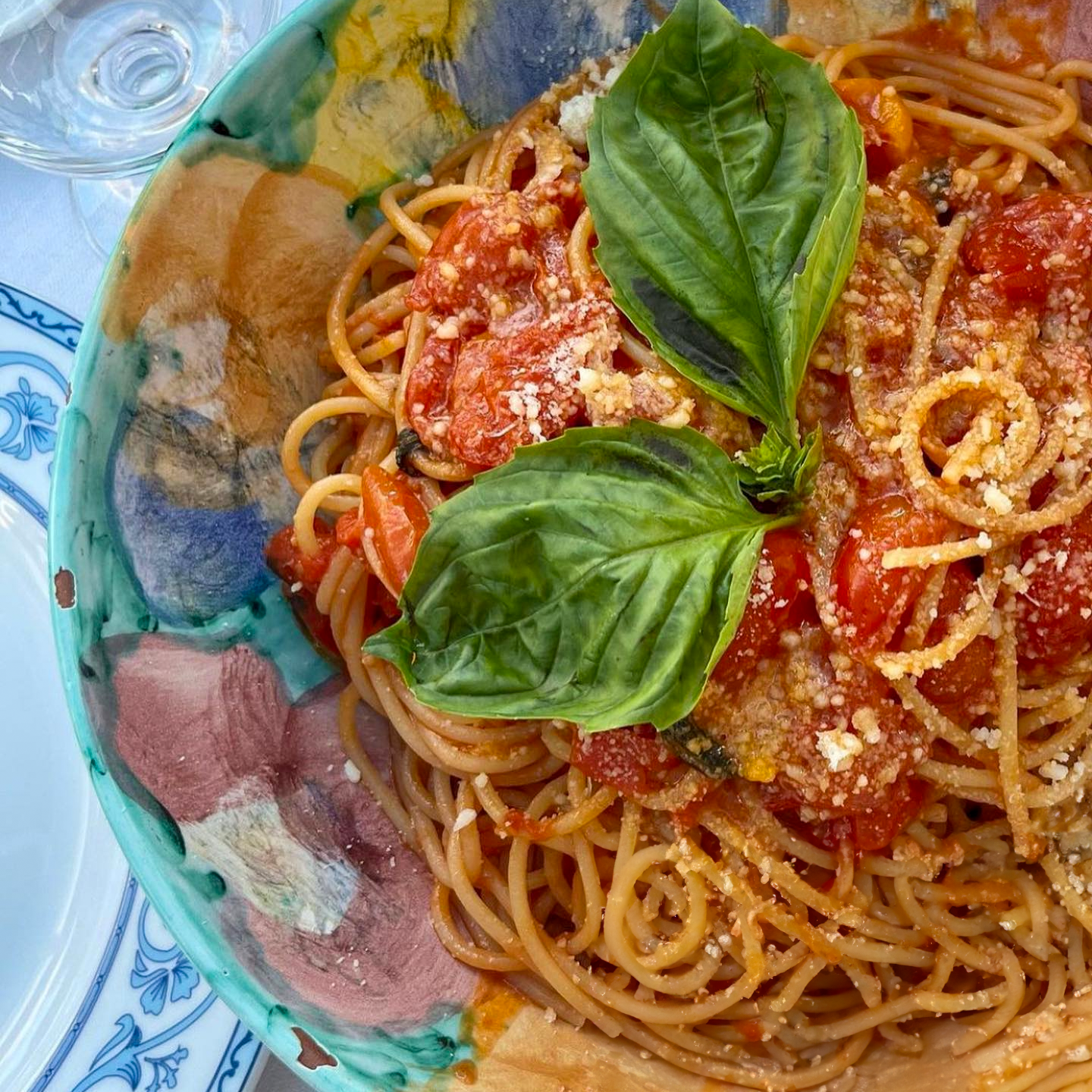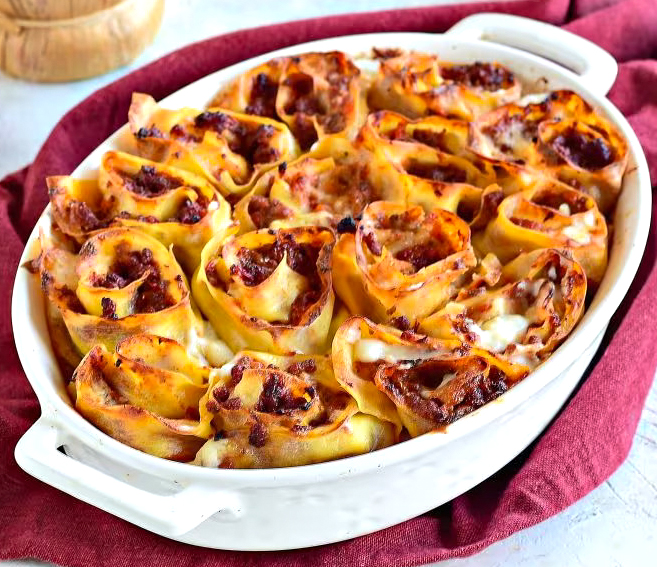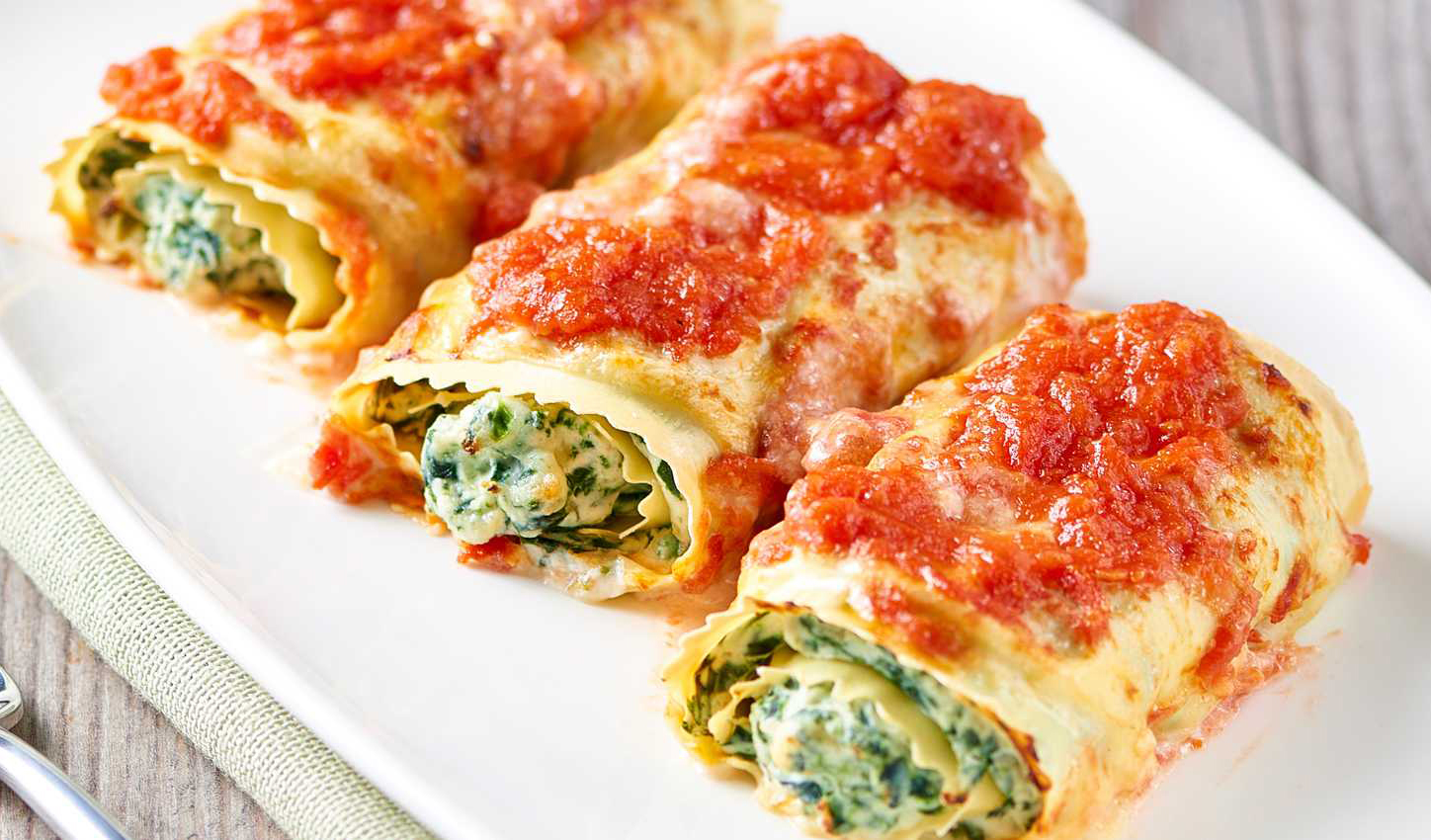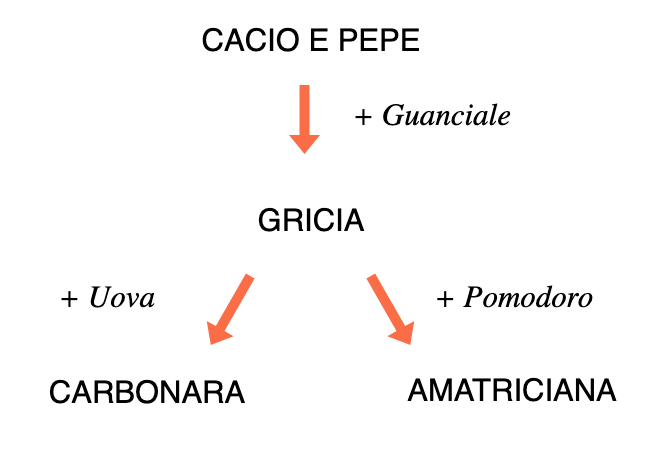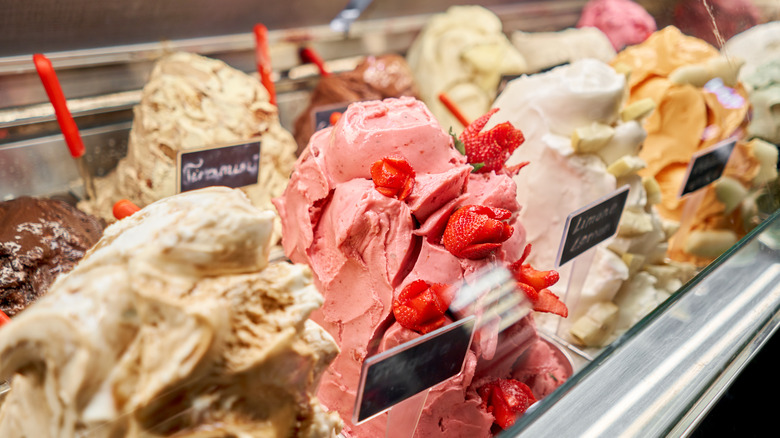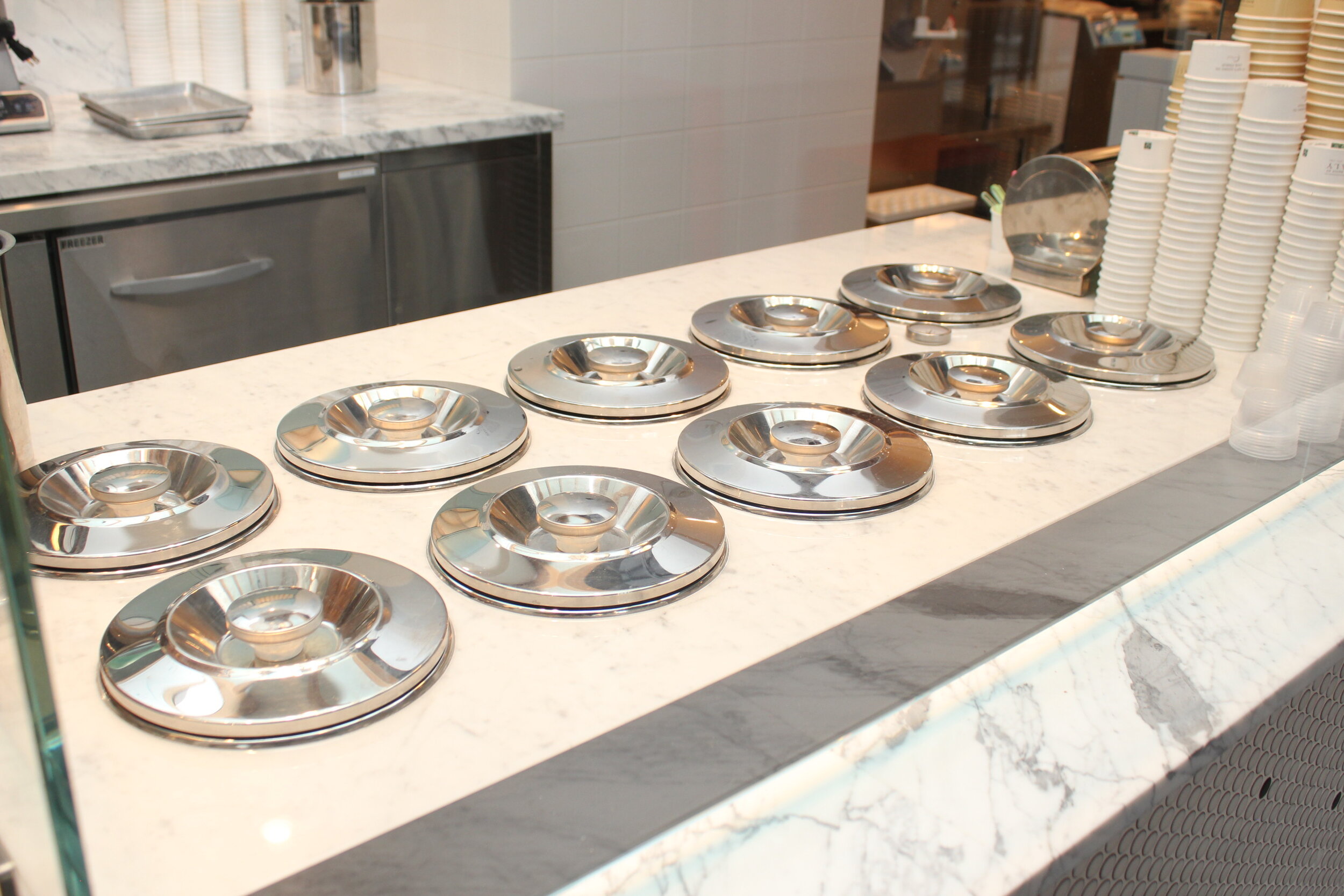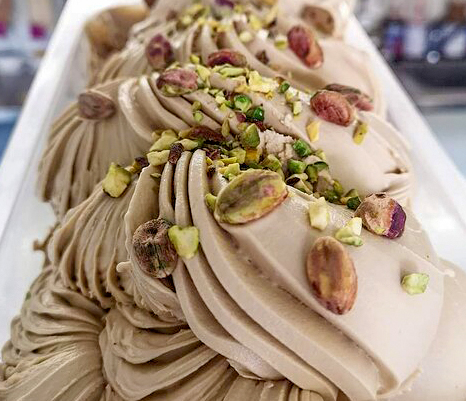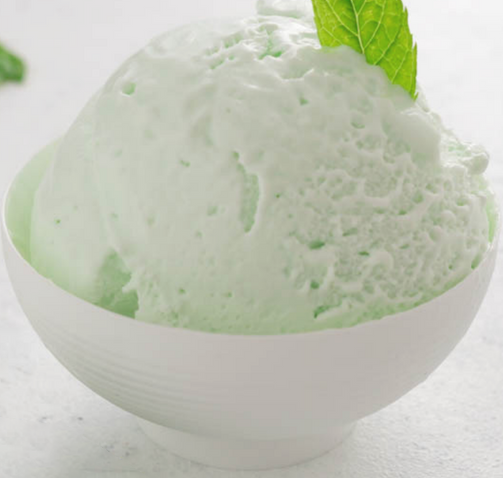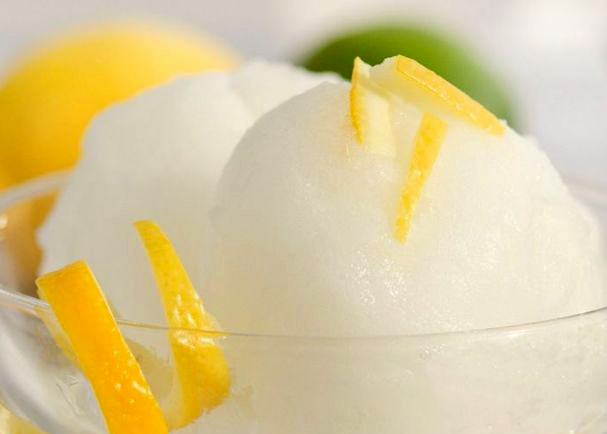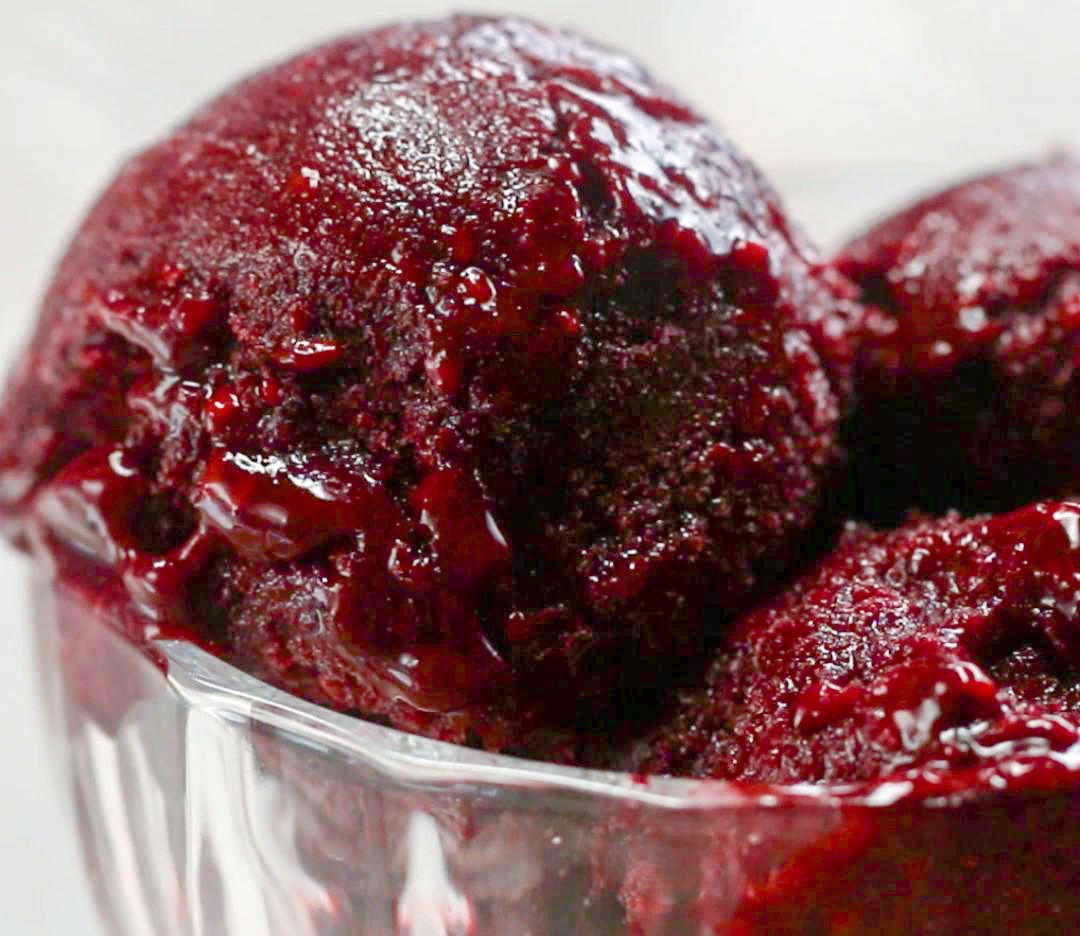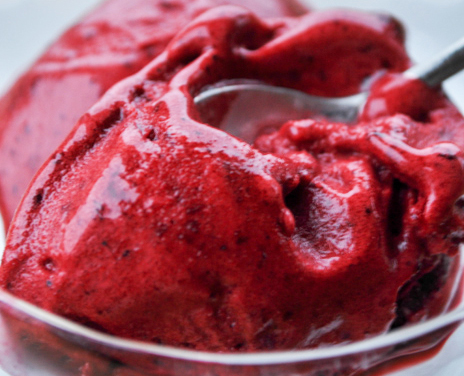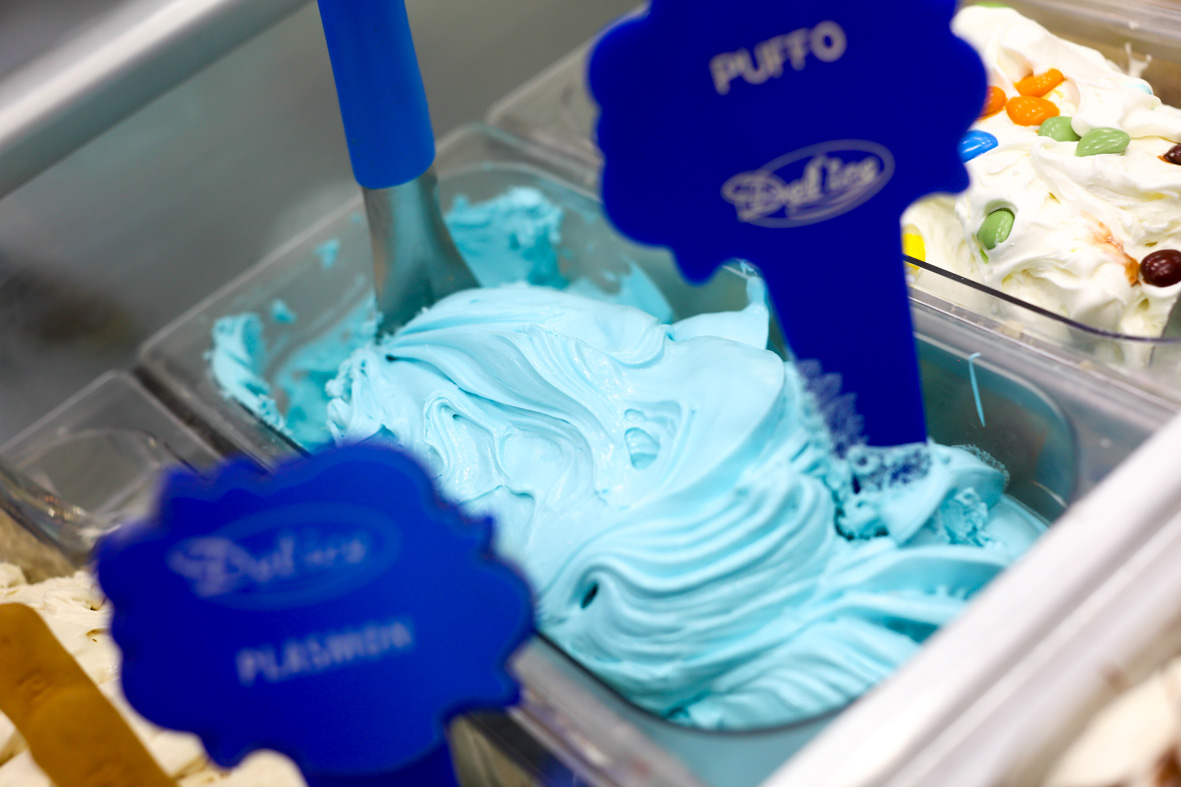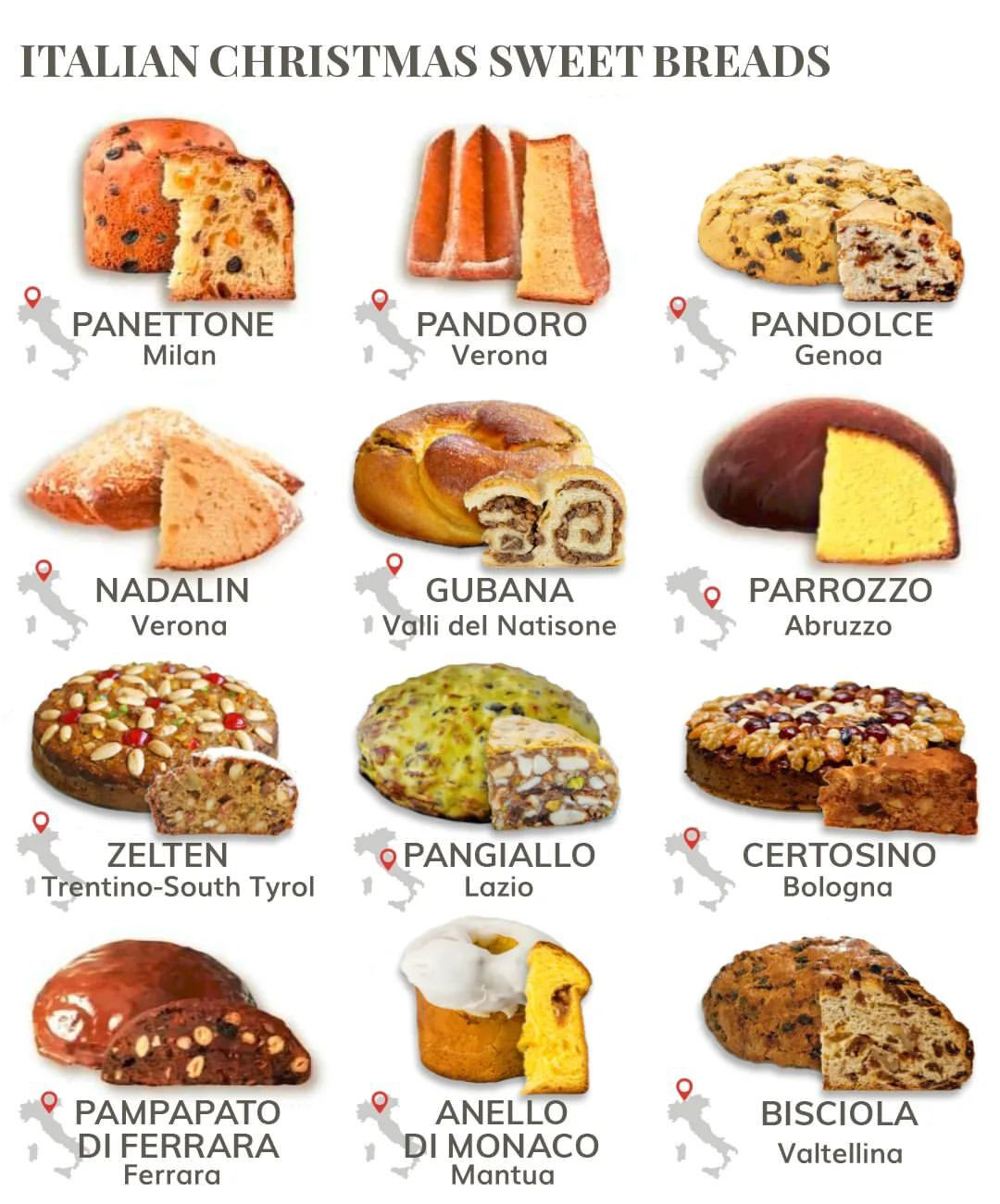Italian Food Reference
by Alex Evins (v.07/25)
|
Pasta Neither dry nor fresh pasta is superior to the other, nor are they interchangeable. They are different and used differently, and for different dishes. Dry pasta is firm and cooked al dente, whereas fresh pasta is soft and delicate and used for stuffed pastas. Fresh pasta cannot be cooked al dente. There are four main types of pasta:
Dry – Semola (Extruded) “Pasta Secca” Virtually All Dry Pastas Including Spaghetti, Linguine, Trenette, Rigatoni, Mezze Maniche, Paccheri, Penne, Reginelle/Mafaldine, etc. (Unless Labeled as Containing Eggs*, e.g. Maccheroncini di Campofilone from Le Marche) (see Pasta Brand Ranking)
Fresh – Semola (Hand Formed) “Pasta Fresca di Semola” Orecchiette/Stacchioddi/Chiancaredde/Strascinati (Puglia and Basilicata)† Cavatelli/Cecatelli (Molise and Puglia) Trofie (Liguria) Maccheroni al Ferro/Ferretto / Fileja (Calabria/Sicily) Scialatielli (Campania) Lagane (South of Italy)† Lorighittas / Gnocchetti Sardi (Sardinia)
Fresh – Soft Wheat (Various) “Pasta Fresca di Grano Tenero” Pici (Tuscany; Hand Pulled)*† (see Pici) Lombrichelli/Umbricelli (Lazio/Umbria; Hand Rolled Long) Maccaronara (Irpinia, Campania; Hand Cut) Strozzapreti (Romagna; Hand Rolled)† Bigoli (Veneto; Extruded)
Fresh – Soft Wheat + Egg (Hand Cut) “Pasta all'Uovo” All Stuffed Pastas (“Paste Ripiene”) Ribbon Pastas† (e.g. Tagliatelle, Fettuccine, Pappardelle; see Ribbon Pastas) Garganelli/Maccheroni al Pettine† (Romagna/Emilia) Troccoli† (Semola; Puglia)* Spaghetti alla Chitarra†/Tonnarelli† (Semola; Abruzzo/Lazio)
*Sometimes made with eggs †Also sold as dry pasta
Northern Italian egg pastas, or paste all'uovo, are traditionally made with soft low-gluten wheat flour (known as “grano tenero,” specifically 0 and 00 flours) instead of hard high-gluten durum wheat semola (known as “grano duro”) that grows in the south of Italy. This is due to the historical concentration of soft wheat cultivation in central-northern Italy, especially in the Po Valley. In the south of Italy, pastas are traditionally made with coarse semola (“semola di grano duro,” known in English as semolina) and, to a lesser extent, fine re-milled semola (“semola rimacinata,” known in English as re-milled semolina). Today, some Italian pastai outside of Emilia-Romagna prefer to use or add semola, or even semola rimacinata, when making pasta all'uovo. For leavened breads, only semola rimacinata and a third product, whole grain durum flour (“farina di grano duro integrale”), can be used. Additionally, the English “semolina” should not be confused with the Italian “semolino,” which refers to a product derived from various ground cereals, including durum wheat, common wheat, corn, rice, and others.
Pici Regional Names/Variations
Risotto Rice Best: Carnaroli, Maratelli, and Vialone Nano Good: Arborio, Baldo, Roma Suitable: Originario, Ribe, Padano Branded Cultivars: Razza 77, Rosa Marchetti
Types of Lasagne al Forno Lasagne Verdi alla Bolognese (Bologna – Spinach Egg Pasta, Béchamel, and Beef/Pancetta Ragù) Lasagne alla Napoletana/di Carnevale (Naples – Dry Pasta, Veal/Pork Ragù, Meatballs, Eggs, Ricotta, etc.) Vincisgrassi (Marche – Egg Pasta, Béchamel, and Pancetta/Prosciutto/Chicken Giblet Ragù) Lasagne al Pesto e Patate (Liguria – Egg Pasta, Béchamel, Potatoes, and Pesto alla Genovese) Lasagne alla Siciliana (Sicily – Dry Pasta, Béchamel, Beef/Pork Ragù, Peas, Mozzarella, ± Hard-Boiled Eggs) Lasagne alla Valdostana (Val d'Aosta – Egg Pasta, Béchamel, Prosciutto Cotto, and Fontina Cheese) Lasagne con Ragù di Agnello (Northern Italy - Egg Pasta, Béchamel, Lamb Ragù, and Provola Cheese) Lasagne alla Ferrarese (Ferrara - Egg Pasta, Béchamel, and Prosciutto Crudo/Beef Ragù) Lasagne alla Parmigiana (Parma - Egg Pasta, Béchamel, Eggplant, Tomatoes, Parmigiano, ± Mozzarella) Lasagne in Brodo alla Molisana (Molise - Egg Pasta, Veal Meatballs, and Mozzarella, Served in Broth) Radicchio Pasticcio (Treviso – Egg Pasta, Béchamel, Chicory, Shallots, and Taleggio)
Regional Pesto Varieties Pesto alla Genovese (Liguria – Basil, Pine Nuts, Garlic, Olive Oil) Pesto di Noci (Liguria – Walnuts, Pine Nuts, Cream, Grana Padano, Breadcrumbs, Garlic, Olive Oil) Pesto di Fave (Liguria – Broad Beans, Mint, Garlic, Olive Oil and Sometimes Pecorino) Pesto Modenese (Emilia-Romagna – Pork Lard, Rosemary, Garlic) Pesto alla Calabrese (Calabria – Tomatoes, Bell Peppers, Tropea Onions, Ricotta, and Chilis) Pesto alla Trapanese/Rosso (Sicily – Almonds, Tomatoes, Basil, Pecorino, Garlic, Olive Oil) Pesto di Pistacchi (Sicily – Pistachios, Basil, Grana Padano, Lemon Zest, Garlic, Olive Oil) Pesto Eoliano (Sicily – Cherry Tomatoes, Basil, Mint, Pistachios, Almonds, Capers, Garlic, Olive Oil) Pesto Pantesco (Pantelleria – Tomatoes, Basil, Parsley, Almonds, Capers, Garlic, Olive Oil) Pesto di Linosa/O’ Pistu Linusaru (Linosa – Tomatoes, Almonds, Basil, Parsley, Pine Nuts, Garlic, Olive Oil) Pesto alla Carlofortina (Sardinia – Tuna, Cherry Tomatoes, Onion, Pesto alla Genovese) Pesto di Finocchietto (Sardinia – Wild Fennel, Pine Nuts, Almonds, Anchovies, Pecorino, Olive Oil)
Regional Ragù Varieties Ragù di Capriolo (Trentino/Lombardy – Roe Deer with Aromatic Herbs) Ragù di Cervo (Friuli – Venison with Aromatic Herbs) Ragù di Frattaglie/alla Cavour (Piedmont – Chicken Livers and Giblets ± Beef) Ragù d'Oca (Lomellina/Lombardy – Goose) Ragù d’Anatra/alla Veneta (Veneto – Tomatoless with Duck)* Ragù alla Bolognese (Bologna/Emilia-Romagna – Beef, Pancetta, Onion, Carrot, Celery, Wine, ± Milk)† Ragù alla Modenese (Modena/Emilia-Romagna – Similar to Ragù alla Bolognese But Mainly Pork and Less Tomato)† Ragù alla Romagnola (Emilia-Romagna – Similar to Ragù alla Bolognese But Without Cream/Milk) Ragù di Coniglio (Emilia-Romagna – Rabbit) Ragù di Piccione (Emilia-Romagna/Tuscany – Pigeon) Ragù di Cinghiale (Tuscany – Wild Boar) Ragù Toscano (Tuscany – Beef/Veal, Sausage, ± Pork, ± Chicken Livers) Ragù di Lepre (Tuscany/Umbria – Hare) Ragù alla Marchigiano (Marche – Variety of Pork, Beef, Chicken Giblets, ± Bone Marrow) Ragù di Agnello/di Castrato/all'Abruzzese (Central Italy/Abruzzo – Lamb) Ragù Molisano/Misto alla Molisana (Molise – Mix of Veal, Lard, Sausage, Pork Rind, and Capocollo) Ragù Napoletano (Campania/Naples – Variety of Pork and Beef Cuts, Including Sausage, Cooked with Onion) Ragù alla Barese/di Braciole (Bari/Puglia – Horse or Veal) Ragù alla Lucana (Basilicata – Sausage and Pork, Minced Lamb and Veal, Browned in Lard) Ragù alla Calabrese (Calabria – Pork: Meat, Ribs, Sausage with Fennel, and Rinds) Ragù alla Siciliana/alla Palermitana (Sicily – Beef/Veal, Pork, and Peas) Ragù di Pecora/alla Sarda (Sardinia – Mutton and Pecorino) Ragù di Cortile (Various – “Courtyard Ragù”: Duck, Chicken, Rabbit, and/or Turkey)
*A ragù is a slow cooked sauce made from chopped or minced meat that usually contains tomato. A tomatoless ragù is known as a white ragù, or Ragù Bianco. The celebrated Neapolitan Sugo alla Genovese (beef, Montoro onions, carrots, celery) could also be considered a type of tomatoless ragù.
†Traditionally in Bologna, minced or coarsely ground diaphragm (“cartella” or “pannicolo”), also known as hanger and outside skirt steak, is used. In addition to or in place of diaphragm, other anterior cuts rich in collagen, such as chuck, brisket, or flank, can also be used.
Notable Regional Pasta Dishes Abruzzo Fettuccine/Spaghetti all'Abruzzese (Pancetta and Onions) Spaghetti alla Chitarra con Pallottine (Mini Meatballs in a Tomato Sauce – Teramo)
Basilicata Strascinati con i Peperoni Cruschi (Dried Crusco Peppers and Breadcrumbs)
Calabria Fileja alla ‘nduja (Nduja, Tomatoes, and Tropea Onions – Province of Vibo Valentia) Fileja alla Silana (Tomato, Sausage, Guanciale, Calabrian Chili, and Caciocavallo – La Sila) Pasta al Pesto Calabrese (Bell Peppers, Ricotta Calabrese, and Calabrian Chili) Pasta al Jonica (Long Pasta, Tomatoes, Calabrian Chilis or Bell Peppers, and Guanciale – Ionian Coast) Rigatoni alla Toranese (Lardo and Tropea Onions – Town of Torano Castello)
Campania Ziti/Candele alla Genovese (Maccheroni della Zita in a Braised Onion and Meat Sauce – Naples) Rigatoni/Candele alla Genovese di Polpo (Braised Onion and Octopus Sauce – Naples) Spaghetti Aglio e Olio (Garlic, Oil, and Chili – Naples) Spaghettoni dei Cornuti/Becchi (Butter, Black Pepper, and Parmigiano – Naples) Spaghetti alla Gennaro (Anchovies, Garlic, and Stale Bread – Naples) Spaghetti allo Scarpariello (Tomatoes, Pecorino Romano, Parmigiano, Basil, and Chili – Naples) Spaghetti allo Scammaro (Raisins, Olives, Capers, and Pine Nuts – Naples) Frittata di Scammaro (Fried Spaghetti with Raisins, Olives, Capers, Pine Nuts, and Anchovies – Naples) Paccheri/Schiaffoni ai Frutti di Mare (Mixed Seafood with Cherry Tomatoes – Naples) Risotto alla Pescatora (Seafood – Naples) Lasagne alla Napoletana/di Carnevale (Meatballs, Veal/Pork Ragù, Eggs, Ricotta, Provola – Naples) Ziti Lardiati (Tomatoes, Lardo di Colonnata, Golden Onions, Pecorino Romano, and Basil – Naples) Calamarata (Calamarata Pasta, Squid, Cherry Tomatoes, Chili, Garlic, Olive Oil, White Wine – Nola) Spaghetti alla Colatura (Anchovy-Based Fish Sauce – Cetara) Spaghetti al Limone (Amalfi Lemons and Butter – Amalfi Coast) Linguine al Limone d'Amalfi con Gamberi Crudi (Amalfi Lemons and Raw Red Shrimp – Amalfi Coast) Scialatielli all'Amalfitana (Cuttlefish, Shrimp, Mussels, Clams, and Piennolo Tomatoes – Amalfi Coast) Spaghetti alla Nerano (Fried Zucchini, Provolone del Monaco, and Salt – Nerano)
Emilia-Romagna Tortellini in Brodo (Meat-filled Tortellini Served in a Capon Broth – Bologna) Tagliatelle alla Bolognese (Beef and Pancetta Ragù – Bologna / Bolognese Bianco = No Tomato) Cappellacci di Zucca (Butternut Squash Stuffed Egg Pasta – Ferrara) Lasagne Verdi alla Bolognese (Spinach Egg Pasta, Béchamel, and Beef and Pancetta Ragù – Bologna) Lasagne alla Parmigiana (Eggplant, Tomatoes, and Mozzarella – Parma) Lasagne alla Ferrarese (Pancetta, Beef, Prosciutto Crudo, Chicken Livers, Béchamel, and More – Ferrara)
Lazio
Roman Pastas (Chart Tonnarelli/Pici Cacio e Pepe (Pecorino Romano and Black Pepper) Mezze Maniche alla Gricia (Pecorino Romano, Black Pepper, and Guanciale) Spaghettoni alla Carbonara (Pecorino Romano, Black Pepper, Guanciale, and Eggs) Bucatini all'Amatriciana (Pecorino, Black Pepper/Chili, Guanciale, and Tomatoes) Rigatoni con la Pajata (Grilled Calf Intestines in a Tomato Sauce – Rome) Rigatoni alla Zozzona (Pork Sausage, Guanciale, Tomato, Egg Yolks, and Pecorino Romano – Rome)
Liguria Trofie/Trenette/Mandilli al Pesto alla Genovese (Basil, Pine Nuts, Garlic, and Olive Oil – Genoa) Trofie con Salsa di Noci alla Genovese (Walnut and Pine Nut Pesto – Genoa) Lasagne al Pesto e Patate (Lasagne al Forno with Potatoes and Pesto alla Genovese – Genoa)
Lombardy Risotto alla Milanese (Saffron – Milan) Riso con Burro e Salvia (Butter and Sage – Milan) Riso alla Pilota (Pork Sausage Meat “Salamella” – Mantua) Casoncelli alla Bresciani (Breadcrumb, Grana Padano, and Nutmeg Stuffed Egg Pasta – Brescia) Casoncelli alla Bergamasca (Meat, Amaretti, Pear, etc. Stuffed Egg Pasta in Butter-Sage – Bergamo) Marubini (Meat, Cheese, Egg, and Bone Marrow or Veal Brain Stuffed Egg Pasta in Broth – Cremona) Tortelli di Zucca (Pumpkin and Amaretti Stuffed Egg Pasta in Brown Butter and Sage – Mantua)
Marche Vincisgrassi (Pasta al Forno with Béchamel and a Pancetta, Prosciutto, Chicken Giblet Ragù) Piconi Ascolani (Easter Breakfast Baked Ravioli Filled with Egg and Cheese – Province of Ascoli Piceno)
Molise Cavatelli al Sugo di Maiale (Pork, Sausage, Onions, and Tomato Purée) Spaghetti alla Molisana (Pancetta Tesa and Chili) Lasagne in Brodo alla Molisana (Lasagne al Forno of Veal Meatballs, Shredded Veal/Chicken, in Broth)
Piedmont Tajarin al Tartufo Bianco (White Truffles and Butter) Agnolotti del Plin Burro, Salvia e Formaggio Grana (Small Meat-filled Agnolotti in Brown Butter, Sage) Risotto al Barolo (Carnaroli Rice and Barolo Red Wine) Gnocchi al Castelmagno (Gnocchi with Butter, Milk or Cream, and Castelmagno Cheese)
Puglia Spaghetti all'Assassina (Burnt Tomatoes and Chili – Bari) Orecchiette con Cime di Rapa (Brocoli Rabe – Bari) Troccoli con Pomodori Secchi, Acciughe e Mollica di Pane (Sun-Dried Tomato, Anchovies, and Breadcrumbs)
Sardinia Spaghetti con la Bottarga (Cured Mullet Roe) Ravioli di Ricotta Sardi (Ricotta di Pecora and Lemon Stuffed Ravioli in Cooked Tomatoes) Lorighittas Con Sugo Di Pollo Ruspante (Lorighittas with a Free-range Chicken and Tomatoe Sauce)
|
|
Sicily Spaghettoni con Tartare di Gamberi Rossi e Stracciatella (Red Shrimp Tartare and Stracciatella) Pasta con le Sarde (Sardines, Raisins, Pine Nuts, and Anchovies) Pasta alla Norma (Maccheroni with Tomato, Fried Eggplant, and Ricotta Secca – Catania) Pasta con Pesto alla Trapanese (Basil, Almonds, Garlic, Olive Oil, Tomatoes, and Salt – Trapani) Pasta con Pesto di Pistacchio (Pistachio and Basil – Cantania) Pasta con la Neonata (Whitebait, Garlic, Olive Oil, and Parsley – Palermo) Pasta 'Ncasciata (Timbale of Maccheroni, Boiled Eggs, Salami, Caciocavallo, and Fried Eggplant – Messina) Lasagne alla Siciliana (Lasagne al Forno with Beef and Pork Ragù, Peas, Béchamel, Mozzarella, and Hard-Boiled Eggs)
Tuscany Pappardelle all'Anatra (Duck Ragù) Pappardelle al Cinghiale (Wild Boar Ragù) Pappardelle alla Lepre (Hare Ragù) Tordelli Lucchese (Beef, Pork, and Bread Stuffed Egg Pasta in a Beef and Pork Ragù – Lucca)
Umbria Spaghetti/Tagliolini alla Norcina (Long Pastas with Black Truffle and Anchovies – Norcia) Penne/Rigatoni alla Norcina (Short Pastas with Sausage, Ricotta di Pecora, and Truffle – Norcia) Strangozzi al Tartufo Nero (Black Truffle and Olive Oil)
Veneto Bigoli con L'anatra (Duck Ragú – Vicenze) Bigoli in Salsa (Anchovies and Onions – Venice) Spaghetti alla Granseola (Spider Crab and Tomato – Venice) Pasticcio al Radicchio (Lasagne al Forno with Chicory, Shallots, Béchamel, and Taleggio – Treviso) Risotto alla Trevigiana (Radicchio – Treviso) Risotto Amarone (Vialone Nano Rice and Amarone Red Wine – Verona)
Other Regions Cjarsons (Perogi-like Stuffed Egg Pasta with Various Sweet or Savory Fillings – Friuli-Venezia Giulia) Lasagne alla Valdostana (Lasagne al Forno with Egg Lasagne, Prosciutto Cotto, and Fontina Cheese – Val d'Aosta)
Various Regions Lasagne con Ragù di Agnello (Lamb Ragù and Provola Cheese; Northern Italy)
Pennette alla Boscaiola (Mushrooms, Sausage, Tomatoes and ± Cream, Pancetta, and Peas – Tuscany and Emilia-Romagna) Spaghetti con Acciughe e Mollica (Anchovies and Breadcrumbs – Sicily and Calabria) Spaghetti Burro e Alici (Butter and Anchovies – Southern Italy) Spaghetti ai Ricci di Mare (Sea Urchin – Campania, Puglia, Sardinia, and Sicily)
Spaghetti alla Vongole (Clams – Campania and Veneto)
|
|
Notes
Fresh vs Dry Pasta: As mentioned above, dry and fresh pasta are not interchangeable. Dry pasta is firm and has a bite to it, whereas fresh pasta is soft and delicate and cannot, by its nature, be cooked al dente as it never possesses the necessary white core
Gelato: The simplicity of gelato, traditionally made from just milk, sugar, and flavorings, allows each ingredient to stand out. Thus, lower-quality ingredients can strongly affect the taste of the final product—more so than ice cream, which has salt, a higher milkfat content, and often multiple flavorings that can more effectively conceal lesser quality ingredients and artificial additives. Most gelaterie use artificial colors and flavors, vegetable oils, milk powder, emulsifiers, thickeners, and/or stabilizers to decrease raw material costs, enlarge batches by incorporating larger amounts of air, and keep the gelato soft. Gelato without additives will freeze solid fairly quickly and will not last overnight, meaning the best gelato must be freshly made every day. There are several easy ways to tell the difference between lower-quality artificial gelato (gelato industriale) and natural artisanal gelato (gelato artigianale naturale). Texture: The best gelato will not rise above the rim of the tub. Tall mountainous heaps
For an overview of basic Italian, see our handy quick reference guide to Italian Pronunciation and Useful Phrases. |
|
Mozzarella Milk: di Bufala (Buffalo) / Fior di Latte (Cow) / Pecora (Sheep)
Size: Ovoline > Bocconcini > Ciliegine > Perle > Perline Shape: Treccia/Treccina (Braided) Nodino (Knotted) Corona di Paestum (Braided Crown) Foglia (Sheet) Mozzarelline (Small Balls) Consistency: Stracciatella (Curds Mixed with Cream) Burrata (Cream Inside the Curd) Moisture: Mozzarella per Pizza (Cow; Lower Moisture)* Flavor: Affumicata (Smoked) Variations: Aversana di Bufala (Original, Large, Full-Bodied) Zizzona di Battipaglia (Giant Bufala Mozzarella) Figliata di Bufala (Stuffed with Smaller Balls) Nera di Bufala (Black, Made with Activated Charcoal)
*Not to be confused with the American low moisture “mozzarella” product sold in block, sliced, or shredded forms—a young cow's milk cheese more reminiscent of caciocavallo or scamorza. For more information on Italian-American cuisine, click here.
There are two slightly different styles of mozzarella di bufala in Campania: one from the Piana del Volturno (centered in and around Caserta, including Aversa) and the other from the Piana del Sele (centered around Salerno and, extending down the Cilentan Coast to, Paestum, including Battipaglia). The former, Casertana style, is richer, saltier, and slightly firmer, whereas the latter, Paestana (or Salernitana) style, is lighter, less salty, and milkier in flavor.
Notable Regional Mozzarella Outside Campania Mozzarella di Brugnato (Liguria; Cow) Mozzarella di Vacca Molisana (Molise; Cow) Mozzarella/Fior di Latte Pugliese (Puglia; Cow) Mozzarella di Gioia del Colle (Puglia; Cow) Mozzarella Lucana (Basilicata; Cow) Mozzarella Silana (Calabria; Cow) Mozzarella Siciliana (Sicily; Buffalo) Burrata di Andria (Puglia; Cow)
Related “Pasta Filata” Stretched-Curd Cheeses Caciocavallo (Hard; Aged; Brined; Cow/Buffalo; Smoked = “Affumicata”; Wine Soaked = "Ubriaco"; Southern Italy) Manteca/Burrino Podolica (Caciocavello Shell Filled with Butter; Basilicata) Pallone di Gravina (Semi-Hard; Aged; Cow; Puglia) Provola (Soft; Aged; Cow/Buffalo; Smoked = “Affumicata”; Southern Italy) Provolone del Monaco (Semi-Hard; Aged; Cow; Naples) Provolone Valpadana (Semi-Hard; Aged; Cow; North of Italy) Scamorza (Semi-Hard; Aged; Cow/Buffalo; Smoked = “Affumicata”; Southern Italy) Stracciata (Semi-Soft; Fresh; Cow; Molise)
Pizza Pizza Napoletana (Naples) Pizza dei Tribunali (Traditional Pizza Napoletana, Characteristic of the Renowned Pizzerias Along Via dei Tribunali) Pizza Ruota di Carro (Extra Wide and Thin Pizza Napoletana; “Wagon Wheel Pizza”) Pizza a Portafoglio (Smaller Folded Pizza Napoletana Sold As Street Food; “Wallet Pizza”) Pizza Canotto/Casertana (Caserta – Contemporary; Large Puffy Crust) Pizza con Cornicione Ripieno (Contemporary; Stuffed Crust, Typically with Ricotta) Calzone (Naples – Baked Stuffed Dough) Pizza Fritta (Naples/Central & Southern Italy – “Fried Pizza”; In Naples, A Fried Stuffed Calzone) Pizza Montanara (Naples – Unstuffed Fried Round Pizza Dough Topped with a Small Amount of Tomato Sauce) Panzerotti (Puglia) / Pidone (Sicily) / Calzone Fritto (Salento) [Regional Names for Pizza Fritta] Pizza Romana (Rome) Pizza Tonda (Round Very Thin and Crispy, “Bassa e Scrocchiarella”) Pizza al Taglio/in Teglia (Rectangular Slices of Thicker Pan Pizza Sold by Weight with Various Toppings) Pizza alla Pala (Rectangular Slices of Thinner Oblong Non-Pan Pizza Sold by Weight with Various Toppings) Pizza Rossa (Cut, Thin Crust Red Pizza, No Cheese; Found in Bakeries) Pizza Bianca (Cut, Thin Crust Plain, No Sauce or Cheese; Found in Bakeries) Pizza Siciliana (Sicily – Sfincione in Palermo) Pizza Pisana (Pisa – Smaller Round Pan Pizza with Medium-Thick Dough) Pizza al Tegamino (Turin – Small Pan Pizza) Pizza al Trancio (Milan – Thick Soft Pan Pizza with Heavy Cheese) Pizza Rustica/Pizza Ripiena (Central/Southern Italy – Stuffed Pizza)* Pizza al Metro (Vico Equense – “Pizza by the Meter”; Variant of Pizza alla Pala Sold Whole) Pizza Secca (Sicily – Thin Crispy Baked Flatbread or Schiacciatina)* Pizzolo (Sicily – Round Stuffed Pizza with Savory or Sweet Fillings)
*Pizza Rustica, Pizza di Pasqua, and Pizza Chiena (also known as scarcedda or cazzola) are stuffed leavened breads, typical of Central and Southern Italy, that are filled with cheese, meats, and eggs and eaten on or around Easter. Pizza di Scarola is a similar dish from Naples that is stuffed with escarole. Here, “pizza” is used with its original medieval Latin meaning of a bread or bread-based dish; other examples of this usage include Pizza di Pasqua (Marche/Umbria), Pizza di Ricotta (Puglia), Pizza Dolce Abruzzese (Abruzzo), and Pizza Dolce di Beridde (Rome).
Regional Focaccia Varieties Focaccia Genovese (Genoa – Olive Oil and Salt) Focaccia di Recco (Genoa – Cheese) Focaccia con le Cipolle (Liguria – Onions) Focaccia Novese (Piedmont – Very Similar to Focaccia Genovese) Focaccia Mantovana (Lombardy – Onions, Made with Pork Suet) Schiacciata all'Olio (Tuscany – Olive Oil and Salt) Focaccia Barese/Pugliese (Bari/Puglia – Fresh Tomatoes and Olives with Potato in the Dough) Focaccia Materana (Basilicata – Tomato Puree, Olives, and Olive Oil) Focaccia Messinese (Messina – Escarole, Tomatoes, Anchovies and Cheese) Focaccia con l'Uva (Various – Grapes) Focaccia di Susa (Piedmont – Sweet Sponge Cake-Like) Focaccia Dolce di Alessandria (Piedmont – Sweet Sugar Topped) Focaccia Veneta (Veneto – Sweet Easter Cake Comparable to Pandoro)
Note on Pinsa: There also exists a decidedly modern creation known as a “pinsa” that is a focaccia-pizza hybrid made from a mix of wheat flour, soy flour, rice flour, and sourdough. Despite marketing this as an ancient dish, it has no connection to Ancient Rome.
Parmigiano Reggiano Production Region: Emilia-Romagna (Delimited Area Around Parma, Reggio Emilia, and Modena) Grazing Areas: Pianura (Po Valley) / Colline (Hills) / Montagna (Mountains; Typically Vacche Rosse) Cow Breeds: Vacche Rosse (“Red Cows” – Reggiana; Original Breed) Vacche Brune (“Brown Cows” – Bruna Italiana/Alpina) Vacche Bianche (“White Cows” – Bianca Modenese; Rare) Italian Frisona (Holstein Friesian Dairy Cows; Industrial) Maturation: 12 months (“Nuovo” – Soft and Moist; Minimum Age for the Industrial Breed) Maturation: 12 months (“Nuovo” – Soft/Moist; Min. Age for the Frisona) 24 months (“Vecchio” – Harder; Minimum Age for the 3 Heritage Breeds) 30 months (“Stravecchio” – Crumbly and Dry; Good For Cooking and Grating) 36 months (“Stravecchio” – Very Crumbly with Prominent Tyrosine Crystals; Good For Grating) ≥48 months (“Stravecchione” – Intense and Spicy; Good For Special Occasions)
Related “Grana” Hard Grainy Cheeses Grana Padano (Raw Cow’s Milk; Aged for ≥9 Months; ≥20 Month = “Riserva”; Less Salty than Parmigiano; Po Valley) Trentingrana (Raw Cow’s Milk Cheese Aged for 16–30 Months; Trentino)
Types of Ricotta Types by Milk: Ricotta di Bufala (Buffalo) Ricotta di Mucca/Vaccina (Cow) Ricotta di Pecora (Sheep) Ricotta di Capra (Goat) Ricotta Mista di Mucca e Pecora (Cow and Sheep) Types by Region: Ricotta Romana (Rome; Sheep's Milk) Ricotta Affumicata Friulana/Veneta (Friuli/Veneto; Cow or Sheep's Milk; Smoked, Firm, Dry) Ricotta Piedmontese (Piedmont; Sheep's Milk) Ricotta Toscana/Pistoiese (Tuscany; Sheep's Milk) Ricotta Salata della Valnerina (Umbria; Sheep's Milk; Salted) Ricotta Salata Abruzzese/di Pecora Stagionata (Abruzzo; Sheep's Milk; Salted) Ricotta Forte (Puglia/Basilicata; Sheep or Goat's Milk; Strong) Ricotta Calabrese (Calabria; Sheep's Milk; Smoked = “Affumicata”) Ricotta Secca/Salata (Sicily; Sheep's Milk; Salted) Ricotta Sarda (Sardinian; Goat's Milk)
Notable Italian Tomatoes Pomodorino del Piennolo del Vesuvio (Naples) Pomodorino Giallo del Piennolo (Naples) Pomodoro San Marzano dell'Agro Sarnese (Salerno) Pomodorino Corbarino/Corbara (Naples/Sorrentine Peninsula) Pomodoro Regina di Torre Canne (Puglia) Pomodoro Fiaschetto di Torre Guaceto (Puglia) Pomodorino Datterino (Puglia) Pomodoro di Pachino (Syracuse) Costoluto Fiorentino (Florence)
Italian Beef Cattle Breeds Chianina (Bistecca alla Fiorentine; Tuscany/Umbria)* Marchigiana (Le Marche/Abruzzo) Piemontese (Most Prevalent; Piedmont) Podolica (Southern Italy) Romagnola (Emilia-Romagna) Maremmana (Southern Tuscany/Northern Lazio)
*Bistecca alla Fiorentina, a thick T-bone, and costata alla Fiorentina, a thick bone-in ribeye, are dry-aged steaks sourced from the Chianina breed of cattle, specifically from young heifers (“scottona”) or steers (“vitellone”), renowned for its lean yet tender meat. Despite its leanness, Chianina meat remains exceptionally tender when served rare, thus bistecca alla Fiorentina is exclusively cooked to a rare or “blue” state (~50°C); grilled over charcoal and seasoned only with salt and extra virgin olive oil (Tuscan Olio Nuovo or Puglian Coratina or Ogliarola). Overcooking, beyond rare, would make the steak tougher and less flavorful, defeating the purpose of using such high-quality meat, celebrated for its tenderness.
Notable Baked Goods and Desserts Brioche Con Gelato (Made with “Brioscia cû Tuppu” from Sicily) Cartellate (Puglia) / Ricciarelli (Siena) [Christmas Sweets] Chiacchiere di Carnevale (Sweet Fried Dough During Carnival from Naples) Cipolline Catanesi (Caramelized Onion and Cheese-Filled Puff Pastry from Catania) Colomba Pasquale (Milan) / Pastiera (Naples) [Easter Desserts] Cornetto Ischitano (Puff Pastry and Brioche Cornetto from Ischia) Delizia al Limone (Lemon Glazed Sponge Cake from Sorrento) Fritole alla Veneziana (Sweet Fritters During Carnival from Venice) Mantovane all'Olio (Bread, Reminiscent of Baijimo or Coco Bread, from Veneto)
Pandoro (Veneto) / Panettone (Milan) / Veneziana (Lombardy) / Bossolà (Brescia) [Christmas Breads Pizza Dolce Abruzzese/Teramana (Layer Cake from Abruzzo) Rustico (Mozzarella, Béchamel, and Tomato Filled Puff Pastry from Salento) Seada (Fried Dough Stuffed with Pecorino Sardo from Sardinia) Sfogliatella (Cream Filled Puff Pastry, Known in the U.S. as a Lobster Tail, from Campania) Sospiri di Bisceglie (“Bride Cake”; Custard Filled Sponge Cake Covered with Icing from Bisceglie in Puglia) Tartufo di Pizzo (Hazelnut-and-Chocolate Gelato Bombe from Pizzo in Calabria)
Other Notable Dishes and Ingredients Bolito Misto (Mixed Boiled Meats from Northern Italy) [Preparation] Cotechino / Zampone (Large Fresh Slow Cooked Pork Sausages from the North of Italy) Cotoletta (Breaded Veal Cutlet; Regional Varieties include alla Bolognese, Milanese, Valtellinese, and Valdostana) Salsiccia di Bra (Raw Veal and Pork Fat Sauasge from Bra) Moeche (Small Soft Shell Crabs from Venice) Gnocco Fritto (Modena/Reggio Emilia) / Crescentina (Bologna) / Torta Fritta (Parma) [Savory Fried Dough] Arrosticini (Grilled Lamb or Mutton Skewers from Abruzzo) Ventricina Teramana/Spalmabile (Spreadable Pork Sausage from Teramo in Northern Abruzzo, Similar to 'Nduja) Gamberi Rossi (Red Shrimp of the Tyrrhenian Sea from Campania/Sicily) Coniglio all'Ischitana (Tomato and Rabbit Stew from Ischia) Lardo di Colonnata (Prized Lardo from Colonnata in Tuscany) Coda alla Vaccinara (Braised Oxtail Stew from Rome) Peschiole (Small Unripe Peaches from Caserta) Torcinello (Grilled Lamb Intestines Wrapped Around Lamb Sweetbreads from Puglia) Stigghiola (Grilled Lamb, Goat, or Chicken Intestines Wrapped Around Onions or Leeks from Palermo) Su Porceddu (Whole Roast Suckling Pig from Sardinia)
Aperitivo Cocktails Campari Soda (Bottled or Mixed Campari and Soda) Campari Orange “Garibaldi” (Campari and Orange Juice) Campari Shakerato (Campari Shaken with Ice) Campari Spritz (Campari, Prosecco, Soda Water) Spritz: Campari (Milan) | Select (Venice) | Aperol (Padua) | Cynar (Padua) | Specialino (Trento) | Hugo (Alto Adige) Bicicletta (Campari, White Wine or Bitter Orange, Soda Water) Boulevardier (Campari, Vermouth, Whiskey) Negroni (Campari, Vermouth, London Dry Gin) Negroni Sbagliato (“Wrong Negroni” – Campari, Vermouth, Sparkling Wine) Milano-Torino “Mi-To” (Campari and Vermouth di Torino, Traditionally Punt e Mes) Americano (Campari, Vermouth, Soda Water) Cardinale (Campari, Dry Vermouth or Riesling, Gin) Pirlo (Brescia – Campari and Still White Wine) Bellini (Venice – Prosecco and Peach Purée) Sgroppino (Venice – Lemon Sorbet, Vodka, Prosecco)
Vermouth Vermouth di Torino (Sweet Aromatized Fortified Red Wine) Vermouth Chinato (Bitter-Sweet Nebbiolo-Based Cinchona and Gentiana Flavored Vermouth; e.g. Cocchi Barolo Chinato) Vermouth con Bitter/Vermouth Amaro (Bitter-Sweet Amaro Flavored Vermouth; e.g. Punt e Mes) Vermouth alla Vaniglia (Sweet Vanilla Flavored Vermouth; e.g. Carpano Antica Formula) Vermouth Bianco (“Dry” Aromatized Fortified White Wine)
Wine Grape Varieties Aglianico (Basilicata/Campania – Aglianico del Vulture and Taurasi) Arneis (Piedmont – Roero Arneis) Barbera (Piedmont – Barbera d'Asti/d'Alba) Cortese (Piedmont – Cortese di Gavi) Corvina and Rondinella (Veneto – Amarone) Dolcetto (Piedmont – Dolcetto di Dogliani/Diano d'Alba) Falanghina (Campania – Falanghina Flegrea and Falanghina Beneventana) Fiano (Campania/Sicily – Fiano di Avellino) Glera (Veneto – Prosecco) Greco Bianco/Greco Nero (Multiple) Lambrusco (Emilia-Romagna/Lombardy) Montepulciano (Multiple – Montepulciano d'Abruzzo) Moscato Bianco (Piedmont – Moscato d'Asti) Nebbiolo (Piedmont – Barolo and Barbaresco) Nero d'Avola (Sicily – Nero d'Avola di Noto and Cerasuolo di Vittoria) Pinot Grigio (Lombardy/Alto Adige/Friuli-Venezia Giulia) Primitivo (Puglia – Primitivo di Manduria) [Zinfandel] Sagrantino (Umbria – Montefalco Sagrantino and Montefalco Rosso) Sangiovese (Tuscany – Chianti, Chianti Classico, Brunello di Montalcino, “Super Tuscans” [e.g. Tignanello]) Trebbiano/Procanico (Multiple – Orvieto and Trebbiano d'Abruzzo) Vermentino (Liguria/Sardinia – Vermentino di Gallura) Vernaccia (Tuscany – Vernaccia di San Gimignano) Zibibbo (Sicily) [Muscat of Alexandria]
Digestivi Amaro (“Bitter” Herbal Liqueur; e.g. Averna, Fernet Branca, Montenegro, Nonino, Zucca) Amaretto (“Little Bitter” Almond Liqueur; Lombardy) Centerbe (“Hundred Herbs” Herbal Liqueur; Abruzzo) Cynar (Artichoke Liqueur; Lombardy) Frangelico (Hazelnut and Herb Liqueur; Piedmont) Galliano (Vanilla and Anise Liqueur; Tuscany) Genepì (Wormwood Liqueur; Piedmont/Valle d’Aosta) Grappa (Grape-Based Pomace Brandy; Northern Italy) Limoncello (Sweet Lemon Liqueur; Campania/Sicily) Fruit -cello's (Yuzu, Melon, Mandarin, Bergamot etc.) Herb -cello's (Fennel, Bay Leaf, etc.) Mirto (Myrtle Berry Liqueur; Sardinia) Nespolino (Loquat Seed Liqueur; Southern Italy) Nocino (Walnut Husk Liqueur; Emilia-Romagna) Ratafià (Black Cherry and Montepulciano-Based Wine Liqueur; Abruzzo) Sambuca (Sweet Anise or Star Anise Liqueur; Lazio) Strega (Saffron, Mint, Fennel, and Herb Liqueur - Benevento; Benevento) Vin Dolce (Dessert Wines) Asti/Asti Spumante (Sparkling Moscato Wine; Piedmont) Marsala (Style of Fortified Wine; Sicily) Moscadello di Montalcino (Muscadelle-Based Wines; Siena) Moscato d'Asti (Lightly Sparkling “Frizzante” Moscato Wine; Piedmont) Passito (Straw/Raisin Wine, Made From Dried Grapes) Picolit (Friuli) Passito di Pantelleria (Zibbo; Pantelleria) Albana (Emilia-Romagna) Sciacchetrà (Cinque Terre) Vin Santo (Trebbiano/Malvasia; Tuscany and Umbria) |
